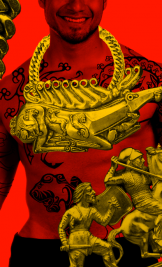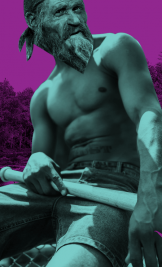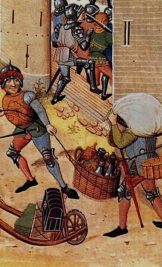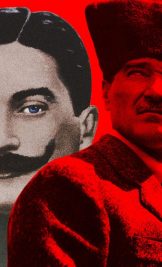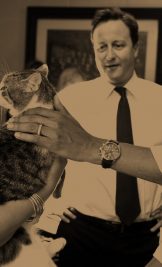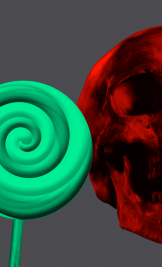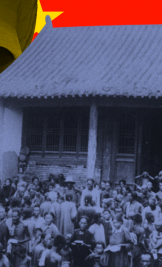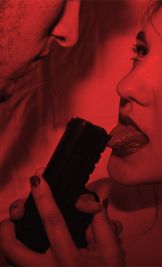

5 stories from the life of outrageous African emperor
There are many legends about Jean-Bédel Bokassa. He is said to eat important enemies with rice, and to order cutting off the penises of the corpses of unimportant ones; to read minds and deflect bullets; to not remember the names of hundreds of his children. However, the ruler of the Central African Republic has such an eventful biography that no fiction can surpass the real facts.
1. How Jean Bokassa got a second name
In 1928, the so-called War of the Hoe Handle began in the French colony of Equatorial Africa, the largest of the uprisings against colonizers that erupted in Black Africa between the two world wars. Karnou, a shaman of the village of Nahing, announced that blacks would soon conquer whites and live in luxury. He claimed that sticks enchanted by him could protect against bullets, and herbs could turn the French into gorillas.
The village refused to pay the rubber tax to the Forestiere company that obtained Nahing as a concession. A French punitive expedition restored order. Karnou was killed.
Among those inspired by Karnou’s sermons was the head of the village of Bobangui, named Mgbundulu. He refused to obey the orders of the French and freed the hostages of Forestiere, as the company held the women and children of its ’employees’ captive so that the men would collect rubber more diligently.
The rebel was beaten to death in the square, and a week later his wife committed suicide. 6-year-old Jean Bokassa becomes an orphan and ends up in a missionary school. He never parted with his grammar book by Jean Bédel.

July 1939. Bokassa joins the French Foreign Legion.
January 30, 1953. Serving in Vietnam, Bokassa marries a local girl that bores him a daughter, Martine.
August 13, 1960. The colony of Equatorial Africa declares independence from France; the new state is named the Central African Republic.
1961. Bokassa is promoted to captain, the highest rank for an African in the French army.
December 1, 1964. Bokassa becomes the first colonel of the Central African Army.
2. How Bokassa spent the New Year usefully
At 10:30 p.m. on December 31, 1965, Bokassa, the CAR’s Minister of Defense at the time, called Izamo, the head of the state guard, to his office to sign some documents. This must be done before the New Year! Izamo was already celebrating at home, but Bokassa convinced him that it would only take a minute.
It is unknown when and how Izamo died. He refused to join the coup, but by the morning of January 1, 1966, the capital city of Bangui was subordinated to Bokassa. His first order was to release everyone from Ngaragba Prison. The second was to imprison President of CAR, David Dacko.
On the afternoon of January 1, Bokassa spoke on the radio and told that he has prevented a coup attempt. Since President Dacko has signed a document of resignation, the minister was forced to take over the government for an indefinite period.
The first coup d’état in postcolonial Africa occurred in 1963. By 1966, foreign diplomats were used to it, so Bokassa had no problem restoring foreign contacts.


1969. Bokassa appoints himself Minister of Information.
April 10, 1969. Bokassa personally kills his rival Captain Banza for participating in a conspiracy.
1970. Bokassa becomes Minister of Agriculture, Health and Population.
November 1970. The French consulate finds a girl of the right appearance in Vietnam, pays her and passes her off as Martine, Bokassa’s lost daughter. She is greeted as a princess in Bangui, but the deception is soon revealed.
1971. Bokassa becomes a general and Minister of Aviation.
February 22, 1971. Bokassa adopts the fake Martine.
3. How Bokassa became a husband
Bokassa was married 17 times, four times before he met his main wife. He met Catherine Denguiadé in 1962 in the streets of Bangui. She was 13, and he was 41. The girl’s father opposed the wedding, but three years later, as Minister of Defense, Bokassa would win her hand in marriage. She would soon become the wife of the president, and then the empress. Catherine was the only one of Bokassa’s wives to be called by her first name, Maman Cathy. The rest were named after their nationality.
Bokassa’s wives can be used to reconstruct the history of his international visits. In the 1970s, he began to bring back girls from his travels abroad. He married eight of them. Gabon, Sweden, Romania, Zaïre, Vietnam, Lebanon, Cameroon, Germany, China…
Bokassa recalled China with particular warmth: ‘One day I attended a parade of high school girls. A hundred stunning girls were waving flags. One of them was so beautiful that I asked her to marry me. Two months later, she arrived in Bangui and we got married. Later she gave birth to two wonderful sons. Such a nice thing, this [diplomatic] protocol.’

June 6, 1971. On Mother’s Day, Bokassa issues a decree to execute all prisoners serving sentences for raping or murdering women. The order is carried out immediately. On the same day, all female prisoners in the Central African Republic are released.
March 4, 1972. The only political party of the Central African Republic declares Bokassa ‘president for life.’
July 29, 1972. Bokassa’s decree provides for cutting off of a thief’s ear for the first offense, a second ear for the second offense, and a right hand for the third offense.
September 29, 1972. Bokassa sends his son Georges to prison for two months for arguing with the father.
1973. Bokassa appoints himself Minister of Public Services and Social Security.
April 1974. Bokassa’s mistress, Brigette Miroux, is found strangled to death. French newspapers accuse Bokassa of the murder. In response, the president nationalizes two local printing concerns owned by the French.
May 15, 1974. Bokassa becomes Marshal of the republic. A ceremonial baton for his new uniform costs 500 thousand francs.
February 3, 1976. A grenade is thrown at Bokassa, but does not explode. The assassination attempt was organized by Fidel Obrou, the husband of the fake Martine.
February 23, 1976. The fake Martin gives birth to a son. On Bokassa’s order, the hospital’s chief physician injects the baby with a lethal dose of drugs.


4. How Bokassa paid $ 100 million for his humiliation
In 1976, Bokassa planned a lavish coronation. The Central African Republic had no money, but France had plenty. However, Europeans were not going to finance the African leader’s madness. So Bokassa became close to Gaddafi’s Libya and converted to Islam. Now France agreed to give money in exchange for his breaking with Gaddafi.
The ceremony, which took place on December 4, 1977, cost $20—25 million, with Bokassa and his main wife wore about a quarter of the amount. The costumes were created by a workshop that had experience working on the coronation of Napoleon: Bokassa was a great admirer of the latter. A giant throne in the shape of an eagle with outstretched wings cost another half a million.
Bokassa rode to the stadium where the coronation would take place in a chariot drawn by eight white horses. An escort of African ‘hussars’ accompanied him. Afterwards, Emperor Bokassa went to mass, feeling like a devout Catholic again. Then there was a reception of important guests, a banquet, fireworks, and a ball with an orchestra.
Not a single head of state attended the ceremony. Of the 2500 Europeans invited, 600 came. The European press mocked the ceremony. Journalists from other African countries competed in wit. The Kenyan Sunday Nation wrote about the ‘clowning glory’ (instead of ‘crowning glory’) of Emperor Bokassa I.
In May 1978, the leader of the Central African Empire in his new status visited the Franco-African Summit in Paris. Special honorable seats were allocated for crowned persons. But Bokassa was again seated between the presidents of Senegal and Côte d’Ivoire. Only the president of Gabon addressed him as ‘Your Imperial Majesty.’ That was all the benefit from the $100 million spent.
1978. Captain François Bozizé has beaten a Frenchman who disrespected Emperor Bokassa. Bokassa appointed him Brigadier General. In 2003, Bozizé organized a successful coup.
5. How Bokassa declared the Day of Peace
Informants of the French journalist Bernard Luba reported that on April 18, 1979, Bokassa visited Ngaragba Prison three times. The first time was at 8 p.m. The emperor beat the arrested students with his famous ‘cane of justice’ with an ivory handle. He returned around midnight and beat the students again, leaving one of them without an eye. Around 3 a.m., the execution continued, and Bokassa was already drunk. The students were packed 50 at a time into the hottest cells of 75 square feet. One of the prisoners saw 18 corpses being taken away in the morning. That was the end of the educational reform in the Central African Empire.
It began with a decree on October 1, 1978. After visiting China, Bokassa introduced the required uniforms for schoolchildren and students. The uniform cost $20, a huge amount by the country’s standards. The order went to a clothing company owned by Emperor’s family. Civil servants had not been paid for two months, and none of them could afford uniforms for their children. On January 15, 1979, children were no longer allowed to go to school without uniforms. The demonstration of lyceum students was dispersed by the police, and all educational institutions in the country were closed. University students put forward political demands. On April 17, mass arrests began.
On April 20, Bokassa declared the Day of Peace on the radio, reminding that he was ‘the father and defender of the nation’ and issuing a decree to ‘protect Central African youth.’
A month later, Amnesty International will issue a report on the April events in London, demanding an international investigation. The scandal marked the beginning of Bokassa’s end. No one doubted anymore that his days were numbered.
September 21, 1979. 2:30 a.m. Bokassa is visiting Libya, and is waken up by his assistants. Former President David Dacko came to power in the Central African Republic with the help of the French military. Operation Barracuda succeeded without a single shot being fired.
September 21–23, 1979. Bokassa is sitting on his plane in Paris, waiting for France to find a country to accept him. Only Côte d’Ivoire agrees, on the condition that Bokassa retires from politics.
November 26, 1983. The Ivorian military does not allow Bokassa’s plane with several dozen mercenaries on board to take off. He was heading to the Central African Republic to regain his throne. The former emperor, his 15 children and numerous wives are thrown out of the country. France allows him to settle under house arrest in the Castle of Hardricourt near Paris.
October 24, 1986. Bokassa returns to the Central African Republic and is arrested on the airplane ramp. He is accused of murder, betrayal of state interests, misappropriation of public funds, and much more. The charges include cannibalism, which is not considered a serious crime in the CAR.
June 12, 1987. Bokassa is found guilty on all charges except cannibalism and sentenced to death.
February 29, 1988. The President of the Central African Republic commutes Bokassa’s sentence to life imprisonment.
August 1, 1993. Bokassa is released under a general amnesty.
November 3, 1996. Jean-Bédel Bokassa dies of a heart attack.
2010. President François Bozizé rehabilitates Jean-Bédel Bokassa, calling him a patriot, a great builder, and a man who brought stability to the country.

